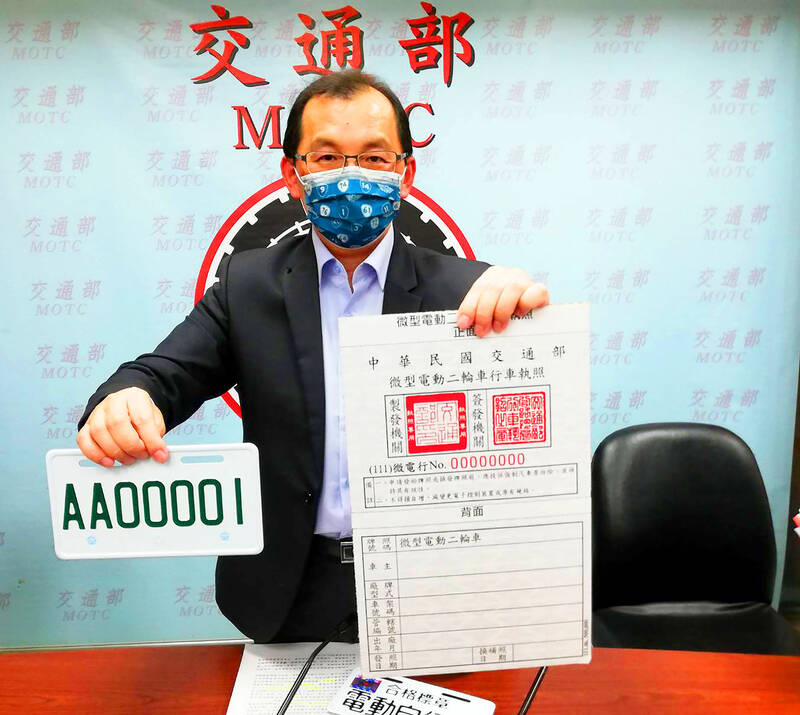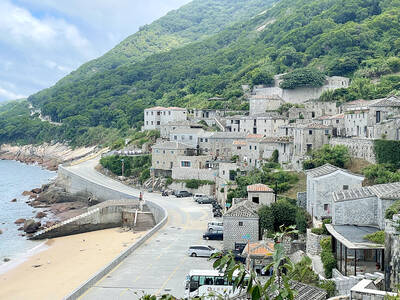Starting on Nov. 30, newly purchased electric bicycles must have license plates, while bikes already in use must be fitted with plates within two years, the Directorate-General of Highways (DGH) said on Friday.
The agency previously did not require electric bikes to have plates due to their relatively low maximum speed, but accidents involving them have necessitated their regulation, Directorate-General of Highways Deputy Director-General Chang Shun-ching (張舜清) said.
About 5,800 accidents involving electric bikes occurred between January and August, killing 33 people, Chang said, adding that there were 4,900 accidents over the same period last year.

Photo: CNA
The incidents have raised concerns about a lack of insurance policies for electric bikes, and the inability to identify drivers who have illegally modified their bikes, or are speeding or contravening other traffic rules, he said.
The regulations would define electric bikes as small two-wheeled electric vehicles with a maximum speed of 25kph and a weight of up to 40kg without the battery or a total weight of up to 60kg, Chang said.
The registration plate would have two letters from the Latin alphabet and a five-digit number, he said.
Driving an electric bike without a license or in a lane not reserved for that type of vehicle would result in a fine of NT$1,200 to NT$3,600, Chang said.
The Financial Supervisory Commission — which is drawing up a tentative insurance scheme — has said that insurance premiums would cost NT$539 for one year or NT$1,990 for five years, he said.
Applicants must apply at a motor vehicle office with their identity card or Alien Resident Certificate, personal stamp, the vehicle’s certificate of origin and purchase invoice, and an insurance certificate, he said, adding that the processing fee would cost NT$450.
Migrant workers may apply with a note from their employer and relevant certificates, Chang added.
He said that additional details are available in multiple languages at www.mvdis.gov.tw/m3-emv-car/car/electricBicycles/eBicyclesDoc.

The Chinese military has built landing bridge ships designed to expand its amphibious options for a potential assault on Taiwan, but their combat effectiveness is limited due to their high vulnerability, a defense expert said in an analysis published on Monday. Shen Ming-shih (沈明室), a research fellow at the Institute for National Defense and Security Research, said that the deployment of such vessels as part of the Chinese People’s Liberation Army (PLA) Navy’s East Sea Fleet signals a strong focus on Taiwan. However, the ships are highly vulnerable to precision strikes, which means they could be destroyed before they achieve their intended

The Taiwan Experience Education Program (TEEP) has funded short-term internships in Taiwan for more than 4,500 young people from more than 40 countries since 2015, with the goal of attracting and retaining international talent, the Ministry of Education said yesterday. Fifty-five colleges launched 514 projects this year, including in fields such as semiconductors, artificial intelligence, medicine and biotechnology, green energy, and sustainability, it said. The program provides research and practical internships in Taiwan for two to six months, and offers cultural exchange and networking opportunities, the ministry said. For example, National Formosa University’s Embedded System and Autopilot Laboratory developed two solar-powered drones in

GLOBAL: Although Matsu has limited capacity for large numbers of domestic tourists, it would be a great high-end destination for international travelers, an official said Lienchiang County’s (Matsu) unique landscape and Cold War history give it great potential to be marketed as a destination for international travelers, Tourism Administration Director General Chen Yu-hsiu (陳玉秀) said at the weekend. Tourism officials traveled to the outlying island for the Matsu Biennial, an art festival that started on Friday to celebrate Matsu’s culture, history and landscape. Travelers to Matsu, which lies about 190km northwest of Taipei, must fly or take the state-run New Taima passenger ship. However, flights are often canceled during fog season from April to June. Chen spoke about her vision to promote Matsu as a tourist attraction in

Taipei resident Mu Chu-hua caught some glimpses of China’s mighty military parade on YouTube on Wednesday. As she watched hypersonic missiles roll down Beijing’s Changan Avenue and troops march in lockstep, she did not feel like they posed a threat to Taiwan. Mu, a 69-year-old retiree, said she saw the parade as simply a way for Chinese President Xi Jinping (習近平) to “say thank you to the troops.” “I thought it was quite normal,” she said. “It was very cool.” China’s military parade commemorating the end of World War II was being watched internationally for insights into Beijing’s military advances and its show